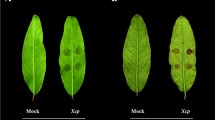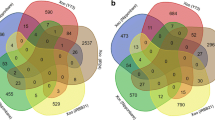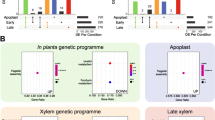Abstract
Key message
An RNAseq-based analysis of the cassava plants inoculated with Xam allowed the identification of transcriptional upregulation of genes involved in jasmonate metabolism, phenylpropanoid biosynthesis and putative targets for a TALE.
Abstract
Cassava bacterial blight, a disease caused by the gram-negative bacterium Xanthomonas axonopodis pv. manihotis (Xam), is a major limitation to cassava production worldwide and especially in developing countries. The molecular mechanisms underlying cassava susceptibility to Xam are currently unknown. To identify host genes and pathways leading to plant susceptibility, we analyzed the transcriptomic responses occurring in cassava plants challenged with either the non-pathogenic Xam strain ORST4, or strain ORST4(TALE1 Xam ) which is pathogenic due to the major virulence transcription activator like effector TALE1 Xam . Both strains triggered similar responses, i.e., induction of genes related to photosynthesis and phenylpropanoid biosynthesis, and repression of genes related to jasmonic acid signaling. Finally, to search for TALE1 Xam virulence targets, we scanned the list of cassava genes induced upon inoculation of ORST4(TALE1 Xam ) for candidates harboring a predicted TALE1 Xam effector binding element in their promoter. Among the six genes identified as potential candidate targets of TALE1 Xam a gene coding for a heat shock transcription factor stands out as the best candidate based on their induction in presence of TALE1 Xam and contain a sequence putatively recognized by TALE1 Xam .




Similar content being viewed by others
References
Abramovitch RB, Anderson JC, Martin GB (2006) Bacterial elicitation and evasion of plant innate immunity. Nat Rev Mol Cell Biol 7:601–611. doi:10.1038/nrm1984
Antony G, Zhou J, Huang S, Li T, Liu B, White F, Yang B (2010) Rice xa13 recessive resistance to bacterial blight is defeated by induction of the disease susceptibility gene Os-11N3. Plant cell 22:3864–3876. doi:10.1105/tpc.110.078964
Bart R, Cohn M, Kassen A, McCallum EJ, Shybut M, Petriello A, Krasileva K, Dahlbeck D, Medina C, Alicai T, Kumar L, Moreira LM, Rodrigues Neto J, Verdier V, Santana MA, Kositcharoenkul N, Vanderschuren H, Gruissem W, Bernal A, Staskawicz BJ (2012) High-throughput genomic sequencing of cassava bacterial blight strains identifies conserved effectors to target for durable resistance. Proc Natl Acad Sci USA 109(28):E1972–E1979. doi:10.1073/pnas.1208003109
Boch J, Scholze H, Schornack S, Landgraf A, Hahn S, Kay S, Lahaye T, Nickstadt A, Bonas U (2009) Breaking the code of DNA binding specificity of TAL-type III effectors. Science 326:1509–1512. doi:10.1126/science.1178811
Bogdanove AJ, Schornack S, Lahaye T (2010) TAL effectors: finding plant genes for disease and defense. Curr Opin Plant Biol 13:394–401. doi:10.1016/j.pbi.2010.04.010
Castiblanco LF, Gil J, Rojas A, Osorio D, Perez Quintero AL, Koebnik R, Szurek B, López C, Restrepo S, Verdier V, Bernal AJ (2013) TALE1 from Xanthomonas axonopodis pv. manihotis acts as a transcriptional activator in plant cells and is important for pathogenicity in cassava plants. Mol Plant Pathol 14:84–95. doi:10.1016/j.pbi.2010.04.010
Chen LQ, Hou B, Lalonde S, Takanaga H, Hartung ML, Qu X, Guo W, Kim JG, Underwood W, Chaudhuri B, Chermak D, Antony G, White FF, Somerville SC, Mudgett MB, Frommer WB (2010) Sugar transporters for intercellular exchange and nutrition of pathogens. Nature 468:527–532. doi:10.1038/nature09606
Chisholm ST, Coaker G, Day B, Staskawicz BJ (2006) Host-microbe interactions: shaping the evolution of the plant immune response. Cell 124:803–814. doi:10.1016/j.cell.2006.02.008
Dash S, Van Hemert J, Hong L, Wise RP, Dickerson JA (2012) PLEXdb: gene expression resources for plants and plant pathogens. Nucleic Acids Res 40:D1194–D1201. doi:10.1093/nar/gkr938
Deslandes L, Rivas S (2012) Catch me if you can: bacterial effectors and plant targets. Trends Plant Sci 17:644–655. doi:10.1016/j.tplants.2012.06.011
Doyle EL, Stoddard BL, Voytas DF, Bogdanove AJ (2013) TAL effectors: highly adaptable phytobacterial virulence factors and readily engineered DNA-targeting proteins. Trends Cell Bio 23:390–398. doi:10.1016/j.tcb.2013.04.003
Du Z, Zhou X, Ling Y, Zhang Z, Su Z (2010) agriGO: a GO analysis toolkit for the agricultural community. Nucleic Acids Res 38:W64–W70. doi:10.1093/nar/gkq310
Edgar R, Domrachev M, Lash AE (2002) Gene expression omnibus: nCBI gene expression and hybridization array data repository. Nucleic Acids Res 30:207–210. doi:10.1093/nar/30.1.20
Glazebrook J (2005) Contrasting mechanisms of defense against biotrophic and necrotrophic pathogens. Annu Rev of Phytopathol 43:205–227. doi:10.1146/annurev.phyto.43.040204.135923
Grau J, Wolf A, Reschke M, Bonas U, Posch S, Boch J (2013) Computational predictions provide insights into the biology of TAL effector target sites. PLoS Comput Biol 9:e1002962. doi:10.1371/journal.pcbi.1002962
Hématy K, Cherk C, Somerville S (2009) Host-pathogen warfare at the plant cell wall. Curr Opin Plant Biol 12:406–413. doi:10.1016/j.pbi.2009.06.007
Hilaire E, Young SA, Willard LH, McGee JD, Sweat T, Chittoor JM, Guikema JA, Leach JE (2001) Vascular defense responses in rice: peroxidase accumulation in xylem parenchyma cells and xylem wall thickening. Mol Plant Microbe Interact 14:1411–1419. doi:10.1094/MPMI.2001.14.12.1411
Jorge V, Fregene M, Duque MC, Bonierbale MW, Tohme J, Verdier V (2000) Genetic mapping of resistance to bacterial blight disease in cassava (Manihot esculenta Crantz). Theor Appl Genet 101:865–872. doi:10.1007/s001220051554
Jorge V, Fregene M, Vélez CM, Tohme DJ, Verdier V (2001) QTL analysis of field resistance to Xanthomonas axonopodis pv. manihotis in cassava. Theor Appl Genet 102:564–571. doi:10.1007/s001220051683
Katsir L, Schilmiller AL, Staswick PE, He SY, Howe GA (2008) COI1 is a critical component of a receptor for jasmonate and the bacterial virulence factor coronatine. Proc Natl Acad Sci USA 105:7100–7105. doi:10.1073/pnas.0802332105
Kay S, Hahn S, Marois E, Hause G, Bonas U (2007) A bacterial effector acts as a plant transcription factor and induces a cell size regulator. Science 318:648–651. doi:10.1126/science.1144956
Kpémoua K, Boher B, Nicole M, Calatayund P, Geiger JP (1996) Cytochemistry of defense responses in cassava infected by Xanthomonas campestris pv. manihotis. Can J of Microbiol 42:1131–1143. doi:10.1139/m96-145
Kunkel BN, Brooks DM (2002) Cross talk between signaling pathways in pathogen defense. Curr Opin Plant Biol 5:325–331. doi:10.1016/S1369-5266(02)00275-3
López CE, Bernal AJ (2012) Cassava bacterial blight: using genomics for the elucidation and management of an old problem. Trop Plant Biol 5:117–126. doi:10.1007/s12042-011-9092-3
López CE, Acosta IF, Jara C, Pedraza F, Gaitán-Solís E, Gallego G, Beebe S, Tohme J (2003) Identifying resistance gene analogs associated with resistances to different pathogens in common bean. Phytopathology 93:88–95. doi:10.1094/PHYTO.2003.93.1.88
López C, Soto M, Restrepo S, Piégu B, Cooke R, Delseny M, Tohme J, Verdier V (2005) Gene expression profile in response to Xanthomonas axonopodis pv. manihotis infection in cassava using a cDNA microarray. Plant Mol Biol 57:393–410. doi:10.1007/s11103-004-7819-3
Lozano JC (1986) Cassava bacterial blight: a manageable disease. Plant Dis 70:1089–1093. doi:10.1094/PD-70-1089
Maddox CE, Laur LM, Tian L (2010) Antibacterial activity of phenolic compounds against the phytopathogen Xylella fastidiosa. Curr Microbiol 60:53–58. doi:10.1007/s00284-009-9501-0
Mak ANS, Bradley P, Cernadas R, Bogdanove AJ, Stoddard BL (2012) The crystal structure of TAL effector PthXo1 bound to its DNA target. Science 335:716–719. doi:10.1126/science.1216211
Megraw M, Hatzigeorgiou AG (2010) MicroRNA promoter analysis. Methods Mol Biol 592:149–161. doi:10.1007/978-1-60327-005-2_11
Miller G, Mittler R (2006) Could heat shock transcription factors function as hydrogen peroxide sensors in plants? Ann Bot 98:279–288. doi:10.1093/aob/mcl107
Moscou MJ, Bogdanove AJ (2009) A simple cipher governs DNA recognition by TAL effectors. Science 326:1501. doi:10.1126/science.1178817
Mukhtar MS, Carvunis AR, Dreze M, Epple P, Steinbrenner J, Moore J, Tasan M, Galli M, Hao T, Nishimura MT, Pevzner SJ, Donovan SE, Ghamsari L, Santhanam B, Romero V, Poulin MM, Gebreab F, Gutierrez BJ, Tam S, Monachello D, Boxem M, Harbort CJ, McDonald N, Gai L, Chen H, He Y, Vandenhaute J, Roth FP, Hill DE, Ecker JR, Vidal M, Beynon J, Braun P, Dangl JL (2011) Independently evolved virulence effectors converge onto hubs in a plant immune system network. Science 333:596–601. doi:10.1126/science.1203659
Muñoz-Bodnar A, Bernal A, Szurek B, López CE (2013) Tell me a tale of TALEs. Mol Biotechnol 53:228–235. doi:10.1007/s12033-012-9619-3
Navarro L, Zipfel C, Rowland O, Keller I, Robatzek S, Boller T, Jones JDG (2004) The transcriptional innate immune Rresponse to flg22. Interplay and overlap with Avr gene-dependent defense responses and bacterial pathogenesis. Plant Physiol 135:1113–1128. doi:10.1104/pp.103.036749.1
Pajerowska-mukhtar KM, Wang W, Tada Y, Oka N, Tucker CL, Fonseca JP, Dong X (2012) The HSF-like transcription factor TBF1 is a major molecular switch for plant growth-to-defense transition. Curr Biol 22:103–112. doi:10.1016/j.cub.2011.12.015
Pérez-Quintero AL, Rodriguez-R LM, Dereeper A, López C, Koebnik R, Szurek B, Cunnac S (2013) An improved method for TAL effectors DNA-binding sites prediction reveals functional convergence in TAL repertoires of Xanthomonas oryzae strains. PLoS One 8:e68464. doi:10.1371/journal.pone.0068464
Pfaffl MW (2001) A new mathematical model for relative quantification in real-time RT-PCR. Nucleic Acids Res 29:e45. doi:10.1093/nar/29.9.e45
Pieterse CMJ, Leon-Reyes A, Van der Ent S, Van Wees SCM (2009) Networking by small-molecule hormones in plant immunity. Nat Chem Biol 5:308–316. doi:10.1038/nchembio.164
Prochnik S, Marri PR, Desany B, Rabinowicz PD, Kodira C, Mohiuddin M, Rodriguez F, Fauquet C, Tohme J, Harkins T, Rokhsar DS, Rounsley S (2012) The cassava genome: current progress, future directions. Trop Plant Biol 5:88–94. doi:10.1007/s12042-011-9088-z
Qi T, Song S, Ren Q, Wu D, Huang H, Chen Y, Fan M, Peng W, Ren C, Xie D (2011) The Jasmonate-ZIM-domain proteins interact with the WD-Repeat/bHLH/MYB complexes to regulate Jasmonate-mediated anthocyanin accumulation and trichome initiation in Arabidopsis thaliana. Plant cell 23:1795–1814. doi:10.1105/tpc.111.083261
Restrepo S, Duque MC, Verdier V (2000) Characterization of pathotypes among isolates of Xanthomonas axonopodis pv. manihotis in Colombia. Plant Pathol 49:680–687. doi:10.1046/j.1365-3059.2000.00513.x
Robert-Seilaniantz A, Grant M, Jones JDG (2011) Hormone crosstalk in plant disease and defense: more than just jasmonate-salicylate antagonism. Annu Rev Phytopathol 49:317–343. doi:10.1146/annurev-phyto-073009-114447
Rosenthal DM, Ort DR (2012) Examining cassava’s potential to enhance food security under climate change. Trop Plant Biol 5:30–38. doi:10.1007/s12042-011-9086-1
Santaella M, Suárez E, López C, González C, Mosquera G, Restrepo S, Tohme J, Badillo A, Verdier V (2004) Identification of genes in cassava that are differentially expressed during infection with Xanthomonas axonopodis pv. manihotis. Mol Plant Pathol 5:549–558. doi:10.1111/J.1364-3703.2004.00254.X
Scharf KD, Berberich T, Ebersberger I, Nover L (2012) The plant heat stress transcription factor (Hsf) family: structure, function and evolution. Biochim Biophys Acta 1819:104–119. doi:10.1016/j.bbagrm.2011.10.002
Soares-Cavalcanti NM, Belarmino LC, Kido E, Pandolfi V, Marcelino-Guimarães FC, Rodrigues F, Pereira G, Benko-Iseppon AM (2012) Overall picture of expressed heat shock factors in glycine max, Lotus japonicus and Medicago truncatula. Genet Mol Biol 35:247–259. doi:10.1590/S1415-47572012000200006
Staswick PE (2008) JAZing up jasmonate signaling. Trends Plant Sci 13:66–71. doi:10.1016/j.tplants.2007.11.011
Streubel J, Pesce C, Hutin M, Koebnik R, Boch J, Szurek B (2013) Five phylogenetically close rice SWEET genes confer TAL effector-mediated susceptibility to Xanthomonas oryzae pv. oryzae. New Phytol 200:808–819. doi:10.1111/nph.12411
Sugio A, Yang B, Zhu T, White FF (2007) Two type III effector genes of Xanthomonas oryzae pv. oryzae control the induction of the host genes OsTFIIAgamma1 and OsTFX1 during bacterial blight of rice. Proc Natl Acad Sci USA 104:10720–10725. doi:10.1073/pnas.0701742104
Suzuki R, Shimodaira H (2006) Pvclust: an R package for assessing the uncertainty in hierarchical clustering. Bioinformatics 22:1540–1542. doi:10.1093/bioinformatics/btl117
Swindell WR, Huebner M, Weber AP (2007) Transcriptional profiling of Arabidopsis heat shock proteins and transcription factors reveals extensive overlap between heat and non-heat stress response pathways. BMC Genomics 8:125. doi:10.1186/1471-2164-8-125
Tao Y, Xie Z, Chen W, Glazebrook J, Chang H, Han B, Zhu T, Zou G, Katagiri F (2003) Quantitative nature of Arabidopsis responses during compatible and incompatible interactions with the bacterial pathogen Pseudomonas syringe. Plant cell 15:317–330. doi:10.1105/tpc.007591.can
Tarazona S, García-Alcalde F, Dopazo J, Ferrer A, Conesa A (2011) Differential expression in RNA-seq: a matter of depth. Genome Res 21:2213–2223. doi:10.1101/gr.124321.111.Freely
Thomma BPHJ, Nürnberger T, Joosten MHAJ (2011) Of PAMPs and effectors: the blurred PTI-ETI dichotomy. Plant cell 23:4–15. doi:10.1105/tpc.110.082602
Trapnell C, Roberts A, Goff L, Pertea G, Kim D, Kelley DR, Pimentel H, Salzberg SL, Rinn JL, Pachter L (2012) Differential gene and transcript expression analysis of RNA-seq experiments with TopHat and Cufflinks. Nat Protoc 7:562–578. doi:10.1038/nprot.2012.016
Vinatzer B, Teitzel GM, Lee MW, Jelenska J, Hotton S, Fairfax K, Jenrette J, Greenberg JT (2006) The type III effector repertoire of Pseudomonas syringae pv. syringae B728a and its role in survival and disease on host and non-host plants. Mol Microbiol 62:26–44. doi:10.1111/j.1365-2958.2006.05350.x
Wasternack C, Hause B (2013) Jasmonates: biosynthesis, perception, signal transduction and action in plant stress response, growth and development. An update to the 2007 review in annals of Botany. Ann Bot 111:1021–1058. doi:10.1093/aob/mct067
Wydra K, Zinsou V, Jorge V, Verdier V (2004) Identification of pathotypes of Xanthomonas axonopodis pv. manihotis in Africa and detection of quantitative trait loci and markers for resistance to bacterial blight of cassava. Phytopathology 94:1084–1093. doi:10.1094/PHYTO.2004.94.10.1084
Xie C, Mao X, Huang J, Ding Y, Wu J, Dong S, Kong L, Gao G, Li CY, Wei L (2011) KOBAS 2.0: a web server for annotation and identification of enriched pathways and diseases. Nucleic Acids Res 39:W316–W322. doi:10.1093/nar/gkr483
Yadeta KA, Thomma BPHJ (2013) The xylem as battleground for plant hosts and vascular wilt pathogens. Front Plant Sci 4:97. doi:10.3389/fpls.2013.00097
Yang B, Sugio A, White FF (2006) Os8N3 is a host disease-susceptibility gene for bacterial blight of rice. Proc Natl Acad Sci USA 103:10503–10508. doi:10.1073/pnas.0604088103
Yilmaz A, Mejia-Guerra MK, Kurz K, Liang X, Welch L, Grotewold E (2011) AGRIS: the Arabidopsis gene regulatory information server, an update. Nucleic Acids Res 39:D1118–D1122. doi:10.1093/nar/gkq1120
Yu Y, Streubel J, Balzergue S, Champion A, Boch J, Koebnik R, Feng J, Verdier V, Szurek B (2011) Colonization of rice leaf blades by an African strain of Xanthomonas oryzae pv. oryzae depends on a new TAL effector that induces the rice nodulin-3 Os11N3 gene. Mol Plant-Microbe Interact 24:1102–1113. doi:10.1094/MPMI-11-10-0254
Zhong S, Joung JG, Zheng Y, Chen Y, Liu B, Shao Y, Xiang JZ, Fei Z, Giovannoni JJ (2011) High-throughput illumina strand-specific RNA sequencing library preparation. Cold Spring Harb Protoc 2011:940–949. doi:10.1101/pdb.prot5652
Zhu X, Thalor SK, Takahashi Y, Berberich T, Kusano T (2012) An inhibitory effect of the sequence-conserved upstream open-reading frame on the translation of the main open-reading frame of HsfB1 transcripts in Arabidopsis. Plant Cell Environ 35:2014–2030. doi:10.1111/j.1365-3040.2012.02533.x
Acknowledgments
AMB was financially supported by a PhD fellowship from DFS, IRD, Sibaghe-UM2 (France) and Ministerio de Agricultura y Desarrollo Rural (Colombia). Funding for BS, AB, CL come from Action Ecos Nord C11A02 and Ministerio de Agricultura y Desarrollo Rural (Colombia). Funding for ALPQ comes from the European Union through Erasmus Mundus Action 2 PRECIoSA Grant Agreement nr. 2012–2646/001–001–EMA2.
Conflict of interest
The authors declare that they have no conflict of interest.
Author information
Authors and Affiliations
Corresponding authors
Additional information
Communicated by Emmanuel Guiderdoni.
A. Muñoz-Bodnar and A. L. Perez-Quintero authors contributed equally to this work.
Electronic supplementary material
Below is the link to the electronic supplementary material.
299_2014_1667_MOESM1_ESM.tif
Supplementary Fig. 1. Bar plots showing the expression profiles of genes grouped in different clusters using k means. Numbers on top of the bars are the mean log FC for each cluster in the respective treatment (TIFF 16362 kb)
299_2014_1667_MOESM2_ESM.tif
Supplementary Fig. 2. Experimental validation of genes induced specifically by “+TALE1 Xam ”. Relative expression values were obtained by comparing each time point with the controls and using the 18S RNA as a reference gene, values in the graph correspond to (2−ΔCt 0dpi)/(2−ΔCt X dpi), where ΔCt = Ctgene − Ct18S. FPKM values for each gene are shown as a comparison (TIFF 2316 kb)
Rights and permissions
About this article
Cite this article
Muñoz-Bodnar, A., Perez-Quintero, A.L., Gomez-Cano, F. et al. RNAseq analysis of cassava reveals similar plant responses upon infection with pathogenic and non-pathogenic strains of Xanthomonas axonopodis pv. manihotis . Plant Cell Rep 33, 1901–1912 (2014). https://doi.org/10.1007/s00299-014-1667-7
Received:
Revised:
Accepted:
Published:
Issue Date:
DOI: https://doi.org/10.1007/s00299-014-1667-7




